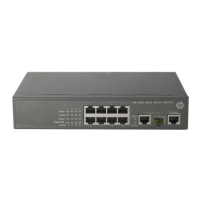Assigning a hybrid port to a VLAN
A hybrid port can carry multiple VLANs. You can assign it to a VLAN in interface view (including Ethernet
interface view, Layer 2 aggregate interface view) or port group view.
Follow these steps to assign a hybrid port to one or multiple VLANs:
To do… Use the command… Remarks
Enter system view system-view —
Enter Ethernet
interface view
interface interface-type
interface-number
Enter Layer 2
aggregate
interface view
interface bridge-aggregation
interface-number
Enter
interface
view
(including
Ethernet
interface
view, Layer 2
aggregate
interface
view) or port
group view
Enter port group
view
port-group manual
port-group-name
Required
Use either command.
• In Ethernet interface view, the
subsequent configurations apply
to the current port.
• In port group view, the subsequent
configurations apply to all ports in
the port group.
• In Layer 2 aggregate interface
view, the subsequent
configurations apply to the Layer 2
aggregate interface and all its
member ports.
Configure the link type of the
port(s) as hybrid
port link-type hybrid Required
Assign the hybrid port(s) to the
specified VLAN(s)
port hybrid vlan vlan-id-list
{ tagged | untagged }
Required
By default, a hybrid port allows only
packets of VLAN 1 to pass through
untagged.
Configure the PVID of the hybrid
port
port hybrid pvid vlan vlan-id
Optional
VLAN 1 is the default by default.
NOTE:
• To change the link type of a port from trunk to hybrid or vice versa, you must set the link type to access
first.
• After you use the port link-type { access | hybrid | trunk } command to change the link type of an
interface, the loopback detection action configured on the interface by using the loopback-detection
action command will be restored to the default. For more information about the loopback-detection
action command, see the
Layer 2—LAN Switching Command Reference
.
• Before you assign a hybrid port to a VLAN, create the VLAN.
• After configuring the PVID for a hybrid port, you must use the port hybrid vlan command to confi
ure
the hybrid port to allow packets from the PVID to pass through, so that the egress port can forward
packets from the PVID.
• After you configure a command on a Layer 2 aggregate interface, the system starts applying the
confi
uration to the a
re
ate interface and its a
re
ation member ports. If the system fails to do tha
on the aggregate interface, it stops applying the configuration to the aggregation member ports. If it
fails to do that on an aggregation member port, it skips the port and moves to the next port.
101

